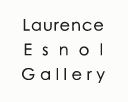Commentaire d’œuvre 7 > Paysage 13 – Alexandre LUTZ


Les grands aplats de couleurs translucides laissent deviner tout de suite la technique de l’œuvre présentée dans le commentaire du jour. L’aquarelle, ici, sur le papier clair, s’étend généreusement sans se fixer de limites réelles. De petit format, l’œuvre semble pourtant s’étendre.
Sur une dizaine de centimètres court un paysage infini et fait de matières tissés par l’imaginaire : on ne sait si l’on voit des champs ou de la roche, une grande ombre emportant toute reconnaissance, ou une étendue de fleurs noires encore inconnues… Au loin, distingue-t-on des habitations, ou de simples reliefs ? Les seules certitudes de cette vision silencieuse aussi cinématographique qu’onirique sont ce vaste ciel indécis et cette grande route qui nous mène à lui. Le contraste des tons clairs et sombres forme une guerre discrète entre le ciel et la terre.
L’atmosphère d’une telle œuvre s’approche de celles qu’Hopper nous a souvent offertes : sans bruit, intrigantes, ne démêlant pas le rêve de la réalité, solitaires et harmonieuses. Le ciel y est semblable aux aquarelles du XIXème siècle, où Boudin, Jongdkind ou Turner ont déjà pensé l’horizon. Mais chaque artiste n’est-il pas voué à repenser toujours la ligne qui le sépare du ciel ?
Laure Saffroy-Lepesqueur
The large areas of translucent color immediately reveal the technique of the work presented in today’s commentary. The watercolor here on the light paper expands generously without setting any real limits. Small in size, the work nevertheless seems to expand.
About ten centimeters creates an infinite landscape made of materials woven by the imagination: we do not know if we see fields or rock, a large shadow where we recognize nothing, or an expanse of black flowers still unknown … In the distance, can we distinguish dwellings, or simple reliefs? The only certainties of this silent vision, as cinematographic as it is dreamlike, are this vast undecided sky and this great road which leads us to it. The contrast of light and dark tones forms a discreet war between heaven and earth.
The atmosphere of such a work approaches those that Hopper has often offered us: quiet, intriguing, not disentangling dream from reality, solitary and harmonious. The sky is similar to the watercolors of the 19th century, where Boudin, Jongdkind or Turner have already thought of the horizon. But isn’t every artist doomed to always rethink the line that separates him from the sky ? academies, these nude drawings of art schools.
But it is also already Degas, who excels « by the keyhole », at representing the suspended moments when the women’s bodies are not represented. And it’s also Courbet, in a loving audacity of the pose, more timid, more intimate and without allegory.
